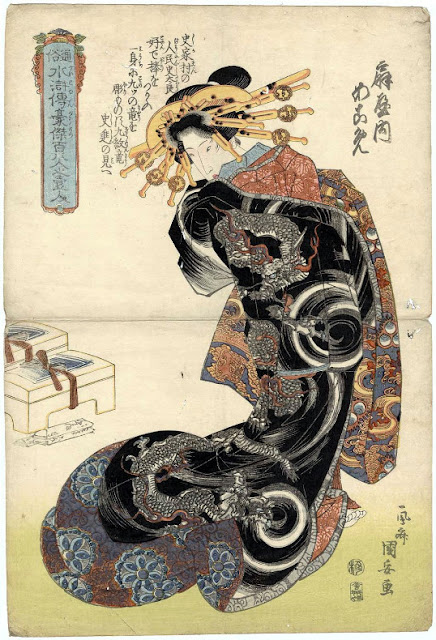 |
| Kuniyasu: Parody of Shi Jin, the Nine Dragoned: Akomi of the Ôgiya |
Here we have one of those hard-to-interpret mitate-e, with many layers of meaning in contrast with each other. At first sight this is nothing more than a bijinga. Indeed, it is a specified woman, Akomi of the Ôgiya. The print is made by Utagawa Kuniyasu (1794-1832), and it is called Parody of Shi Jin, the Nine Dragoned (Kyûmonryû Shishin no mitate): Akomi of the Ôgiya; from the series One Hundred and Eight Heroes of the Popular Shuihuzhuan (Tsûzoku Suikoden gôketsu hyakuhachinin no hitori)."
The Ôgiya was a great brothel in Yoshiwara, Edo's pleasure district. Many ukiyo-e artists created bijinga with portraits of courtesans from this "House". As so many aspects of life in old Japan, a brothel, or a "House", was organised according to a strict hierarchy. The reigning courtesan of the Ôgiya had the hereditary name Hana-o gi.
But who is Shi Jin, the nine-dragoned, with whom Kuniyasu contrasts the courtesan?
He is a character in a Chinese literary classic, Shuǐhǔ Zhuàn (Water Margin). The story is too long to be told here, but Shi Jin had nine dragon tattoos on his body. Compare that to the pattern of the courtesan's kimono.
It is customary to translate "mitate" to "parody", but it can be misleading. I have explained that in a previous article.
He is a character in a Chinese literary classic, Shuǐhǔ Zhuàn (Water Margin). The story is too long to be told here, but Shi Jin had nine dragon tattoos on his body. Compare that to the pattern of the courtesan's kimono.
It is customary to translate "mitate" to "parody", but it can be misleading. I have explained that in a previous article.